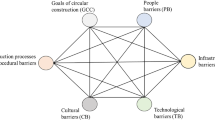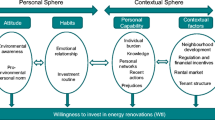Abstract
Emission Trading System (ETS) has been promoted as a tool for providing financial and cost-effective incentives to the GHG emitters to implement emission reduction measures. The ETS has been applied in many energy-intensive industries internationally. However, its implementation in building sector appears encountering many challenges due to the unique characteristics of buildings. This study attempts to identify and analyze the key factors within the context of China. Research data are from semi-structured interviews with a selected group of ETS experts from official and academia. Fifteen representative factors have been identified from extensive content analysis and validated with experts’ opinions. Among these representative factors, some are key factors playing critical and essential roles. This paper applies the Social Network Analysis (SNA) to find the key factors. Finally, it is found that there are four factors considered as the most important influence factors, including “government”, “emitters”, “the scattered energy consumption and carbon emission in building sector”, and “decentralization of property rights in building sector”. The findings from the study provide valuable reference for decision-making in promoting ETS in those developing countries such as China where carbon emission in building sector contributes considerably to environmental pollution.
Access this chapter
Tax calculation will be finalised at checkout
Purchases are for personal use only
Similar content being viewed by others
References
Al-Sallal KA (2014) A review of buildings’ energy challenges. Int J Environ Sustain (IJES) 3
Attri R, Dev N, Sharma V (2013) Interpretive structural modelling (ISM) approach: an overview. Res J Manage Sci 2319:1171
Bartels C, Berlin K, Cavey EA, Desiderio M, Lesmes S, Raines FD, Sahadi RJ (2005) System and method for residential emissions trading. Google Patents
Berelson B (1969) Content analysis for the social sciences and humanities. Addisson-Wesley, Reading
Borgatti SP (2005) Centrality and network flow. Soc Netw 27:55–71
Cantner U, Graf H (2006) The network of innovators in Jena: an application of social network analysis. Res Policy 35:463–480
Demailly D, Quirion P (2008) European Emission Trading Scheme and competitiveness: a case study on the iron and steel industry. Energy Econ 30:2009–2027
Eom J, Clark L, Kim SH, Kyle P, Patel PL (2012) China’s building energy use: a long-term perspective based on a detailed assessment. PNNL report, PNNL-21073
Freeman LC (1977) A set of measures of centrality based on betweenness. Sociometry 35–41
Freeman LC (1979) Centrality in social networks conceptual clarification. Soc Netw 1:215–239
Ge X (2014) Key element identification in cooperative technological innovation risk on social network analysis 316–319
Greiner S, Lieberg K (2011) Carbon trading in the Chinese building sector. Greenhouse Gas Market Rep 2011:26–29
Guo Y (2012) Influence factors analysis of co operative innovation for aeronautical enterprises based on social network analysis. J Ind Technol Econ 7:011
Han G, Olsson M, Hallding K, Lunsford D (2012) China’s carbon emission trading. An overview of current development. Stockholm: FORES/Stockholm Environment Institute. Online at: http://www.sei-international.org/publications
Hou J, Wu Y, Liu Y (2014) Research on the marketization ways of existing public buildings’. Energy Effi Retrofit 21:10001–10005
Huang Y-L, Xiong Y (2010) Key element recognition of regional innovation environment based on social network analysis. J Beijing Univ Posts Telecommun (Soc Sci Ed) 2:019
Jiang JJ, Ye B, Ma XM (2014) The construction of Shenzhen’s carbon emission trading scheme. Energy Policy 75:17–21
Jiang MP, Tovey K (2010) Overcoming barriers to implementation of carbon reduction strategies in large commercial buildings in China. Build Environ 45:856–864
Jotzo F (2013) Emissions trading in China: principles, design options and lessons from international practice. Centre for Climate Economics & Policy, Crawford School of Public Policy, The Australian National University
Krippendorff K (2012) Content analysis: an introduction to its methodology. Sage
Lam P, Chan EHW, Yu ATW, Cam WCN, Yu JS (2014) Mitigating climate change in the building sector. Facilities 32:342–364
Li J, Colombier M (2010) Economic instruments for mitigating carbon emissions: scaling up carbon finance in China’s buildings sector. Clim Change 107:567–591
Liu X, Wu Y, Chen X (2013) An overview of building emission trading system development in China. Urban Dev Stud 20:64–69
Nejat P, Jomehzadeh F, Taheri MM, Gohari M, Majid MZA (2015) A global review of energy consumption, CO2 emissions and policy in the residential sector (with an overview of the top ten CO2 emitting countries). Renew Sustain Energy Rev 43:843–862
Nishida Y, Hua Y (2011) Motivating stakeholders to deliver change: Tokyo’s Cap-and-Trade Program. Build Res Inf 39:518–533
Oberheitmann A (2012) CO2-emission reduction in China’s residential building sector and contribution to the national climate change mitigation targets in 2020. Mitig Adapt Strat Glob Change 17:769–791
Peng M (2013) Analysis on the status and feasibility of the emission trading system in the Chinese building sector. Constr Sci Technol 16:57–61
Perdan S, Azapagic A (2011) Carbon trading: current schemes and future developments. Energy Policy 39:6040–6054
Ren H, Lu Y, Cai W, Xie Q (2013) Study on framework of buildings’ carbon emissions trading in China. Urban Dev Stud 20:70–76
Shen L, He B, Jiao L, Song X, Zhang X (2015) Research on the development of main policy instruments for improving building energy-efficiency. J Cleaner Prod
Shen W (2014) Chinese business at the dawn of its domestic emissions trading scheme: incentives and barriers to participation in carbon trading. Clim Policy 1–16
Shih H-Y (2006) Network characteristics of drive tourism destinations: an application of network analysis in tourism. Tour Manag 27:1029–1039
Swan LG, Ugursal VI (2009) Modeling of end-use energy consumption in the residential sector: a review of modeling techniques. Renew Sustain Energy Rev 13:1819–1835
Tang L, Wu J, Yu L, Bao Q (2015) Carbon emissions trading scheme exploration in China: a multi-agent-based model. Energy Policy 81:152–169
Weber RP (1990) Basic content analysis, quantitative applications in the social sciences, vol 19. Sage Publications, Inc, Beverly Hills, CA, pp 24–26
Yao X, Yang Y, Fu YJ, Li YL, Wu GS (2014) Hot issues detection on Weibo based on social network analysis. Adv Mater Res Trans Tech Publ 1818–1825
Yu ATW, Wu Y, Zheng B, Zhang X, Shen L (2014) Identifying risk factors of urban-rural conflict in urbanization: a case of China. Habitat Int 44:177–185
Zhang D, Karplus VJ, Cassisa C, Zhang X (2014) Emissions trading in China: progress and prospects. Energy Policy 75:9–16
Zhang F, Guo Y, Chen X (2011) Research on China’s Power sector carbon emissions trading mechanism. Energy Procedia 12:127–132
Zhang H (2013) Emissions trading and China: learning by doing and implications for policy making. Aust Environ Rev 28:690–694
Acknowledgments
This research is funded by the Key Project of the National Natural Science Fund of China (Project No: 15AZD025).
Author information
Authors and Affiliations
Corresponding author
Editor information
Editors and Affiliations
Rights and permissions
Copyright information
© 2017 Springer Science+Business Media Singapore
About this paper
Cite this paper
Song, X., Shen, L., Yam, M.C.H., Zhao, Z. (2017). SNA Based Identification of Key Factors Affecting the Implementation of Emission Trading System (ETS) in Building Sector: A Study in the Context of China. In: Wu, Y., Zheng, S., Luo, J., Wang, W., Mo, Z., Shan, L. (eds) Proceedings of the 20th International Symposium on Advancement of Construction Management and Real Estate. Springer, Singapore. https://doi.org/10.1007/978-981-10-0855-9_52
Download citation
DOI: https://doi.org/10.1007/978-981-10-0855-9_52
Published:
Publisher Name: Springer, Singapore
Print ISBN: 978-981-10-0854-2
Online ISBN: 978-981-10-0855-9
eBook Packages: EngineeringEngineering (R0)




